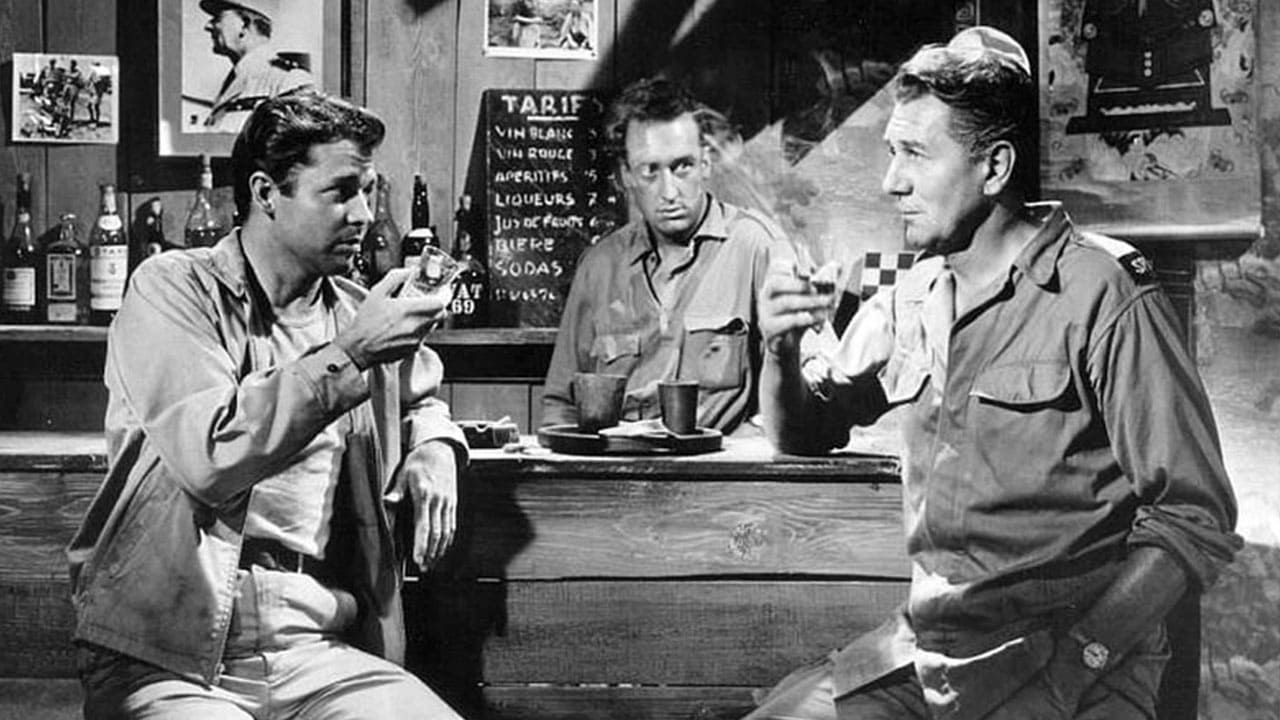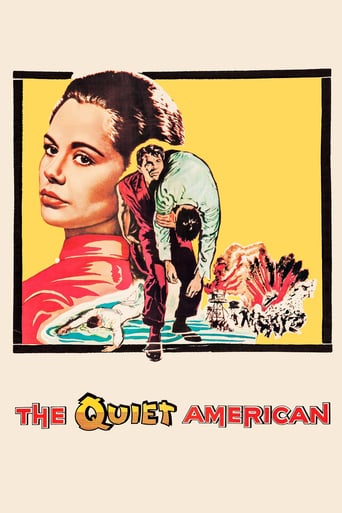

While I'm familiar with the name Graham Greene I've never read one of his books. Of his works the only one I've ever seen was THE THIRD MAN for which he wrote the screenplay based on his own novella. So when I took to watching this movie I was interested to see what I'd make of it.The story is more romance than spy story though it has elements of both. It takes place in the mid-fifties in Vietnam, a country poised on the brink of war and being tugged at both ends by different political factions. The tale is told through the eyes of British foreign correspondent Thomas Fowler (Michael Redgrave), a world weary reporter who's seen it all and has little hope for peaceful solutions.Fowler lives in an apartment with his companion Phuong (Giorgia Moll), a young Vietnamese girl who hopes to accompany him when he returns home. Fowler has told her that when he does so he will divorce his wife and the two of them will live together but the reality is that his wife, a devout Catholic, is unwilling to give him a divorce.Into their lives enters Alden Pyle (Audie Murphy). Pyle is unnamed in the movie but named in the book. Pyle supposedly works for an import/export business in town but in reality is an agent of the CIA. Dedicated to his job and believing that there is a solution to the problems in the country, he befriends first Fowler to learn more and then becomes enamored with Phuong. While Fowler has no real intention of taking Phuong with him, he finds himself insanely jealous of the attention Pyle shows her.Parts of this are interesting to watch as the two men discuss their intentions and Phuong not necessarily as a human being but as something they can barter over. Both have different beliefs about her, Fowler that she will just go along with the political climate offered here and Pyle that she can become an American with a sympathetic lifestyle. Her attitude towards it all is simple, she just wants to leave the country and go somewhere that has more opportunity. Eventually the romantic triangle must find a solution.Just how far Fowler is willing to go to put an end to his potential rival becomes a big part of the third act of the film. Midway through the pair find themselves stuck in a watchtower and have time to discuss their differing political views. Ever the cynic Fowler finds Pyle to be naïve rather than informed. None of it bodes well for Pyle.The film was supposed to be an anti-war piece but was twisted during production. Much of that revolved around the fact that this was during the blacklist period of Hollywood and the fear was it would be construed as a pro-Communist film. One thing it did so was predict the difficulties that would take place in Vietnam in years to follow. While a critical success it wasn't a huge hit at the box office.I think part of the reason for this was the structure of the film. It plays like a book and at times can be overly wordy. With little action to be found the movie crawls at a snail's pace while we wait to see what happens. Murphy was a star by this time, a decorated WWII hero who was known to play in westerns. This was a change of pace and it may have confused movie goers at the time. Still it makes for an interesting look at a topic rarely covered this way when it comes to Vietnam.Twilight Time provides the standard great looking picture with this release but few extras. All you will find here are an isolated music track with some effects and the theatrical trailer. But if interested make sure you pick one up before they're gone as the standard 3,000 copies have been made for release.
... View MoreFascinating and emotive political/drama /thriller set during Vietnam war with intervention of France and US . It boasts a very good cast such as Audie Murphy as the American , Michael Redgrave as Thomas Fowler , Bruce Cabot and Claude Dauphin as Inspector Vigot . It is Saigon set , at the time of Chinese New year 1952 . There was an emperor who ruled by permission of France to whom it belonged and 300 miles to the North of Saigon , both the emperor and the French were fighting a war against a communist army . But at war or in peace Chinese New Year was a time to forgive one's enemies square accountants with one's God and creditors and to rejoice is a world that , for two days , night be considered a happy one . Entertaining as well as taut picture dealing with a central romance along with thrills , political details and warlike deeds about Vietnam versus France conflicts . A young naive American named Alden Pyle (Audie Murphy) and a cynical older British journalist called Fowler (Michael Redgrave) disagree over politics in 1952 Vietnam and over a beautiful young native girl called Phuong (Giorgia Moll) . As a ¨quiet American¨ with dark secrets arrives in Saigon with his own plan to settle country's conflicts . As it's not clear whether Alden Pyle is just what he appears , as he seems to be an innocent young American opposite the older , intelligent Thomas Fowler . Eventually Fowler must confront moral conflicts and the relationship between Pyle and him reaches some problems connected with a Vietnamese General , at the same time the war and a political upheaval take place .Interesting first rendition of the Graham Greene novel including a love triangle , emotion , wartime events and many other things . The picture relies heavily on the love triangle between the ironical British reporter , his enticing mistress and the strange quiet American , but it doesn't boring , neither tiring and nor dull . Michael Redgrave is very good as a correspondent covering a conflict and finding himself becoming personally involved when he befriends an American who is not all that he seems to and also falling for a beautiful young Vietnamese , a mesmerizing Giorgia Moll . Audie Murphy gives a career-best acting as the title role . The movie has its touching moments found primarily in the superb performances from trio protagonist . The movie received many good reviews at various International Film Festivals , but other places was panned by critics . In fact , in Europe, director-writer Joseph L. Mankiewicz was savagely attacked for his film's infidelity to the source novel by Graham Greene, not least by Greene himself . The screenplay essentially turns the novel inside-out, so that the blundering "quiet American", whose extreme naiveté causes tragedies . The flick is dedicated to the people of the Republic of Vietnam , to their chosen President and administrators , wishing our appreciation for their help and kindness . The picture contains an adequate and evocative musical score by Mario Nascimbene , including oriental sounds . Furthermore , and atmospheric cinematography in black and white by Robert Krasker . This handsomely mounted flick was well directed by , resulted to be more a killing mystery than the political/drama , being compellingly directed by Joseph L. Mankiewicz .The second version (2002) was realized by Phillip Noyce . The US release of this movie was delayed for more than a year by the terrorist attacks on the USA of 11 September 2001 . The producers were concerned that it would be seen as anti-American and Miramax decided to release this movie in the United States theatrically . The film ends with newspaper stories written by Thomas Fowler about Vietnam from 1954 to 1966 ; however , the book on which the film was based was published in 1955 , so these are mostly events which happened after the book came out . It was starred by Brendan Fraser , Michael Caine , Do Thi Hai Yen as Phuong , while this last retelling turned to be more faithful to Graham Greene than Joseph L. Mankiewicz's 1958 take on Graham Greene novel .
... View More"A young naive American and a cynical older British diplomat disagree over politics in 1952 Vietnam and over a beautiful young native girl. " The Quiet American features Audie Murphy as the role of The American in search of a "thrid force" in Vietnam, Michael Redgrave as Thomas Fowler, a British correspondent covering the Indo-China War, and Giorgia Moll as Phuong, Fowler's mistress. When Fowler and The American end up in a Vietnam guard tower, we are treated to Vietnam's pitch black night and the War's prominent gunfire. They are seated with two Vietnam boys who barley know how to operate a gun. All four of them are huddle together in this small bird's nest, unaware if they'll be alive tomorrow morning.
... View MoreThe Quiet American has a lot to live up to, because it is adapted from possibly the best book that Graham Greene ever wrote. However, it is a very well made and literate film which manages to make a reasonable stab at living up to the forbidding reputation of its source material. Audie Murphy gives a career-best performance as the title character, an American living in Vietnam during the French incursion into the country. He believes that he can make a difference by providing funding for arms, but his political and economic beliefs often lead to death and destruction. A British journalist named Fowler (Michael Redgrave) befriends him, but soon their friendship is damaged when the young American has an affair with Fowler's Vietnamese mistress. In the end, Fowler ponders whether to betray the American to his enemies as an act of revenge for what the American has done to his love-life. The film is powerful, absorbing and well-acted. It perhaps could be criticised for the extraordinarily high amount of dialogue (it's one of those films where if you stop listening for 30 seconds, you'll lose the plot) but that is probably the only true weakness. The themes of betrayal, colonialism, and the wisdom of interfering in the affairs of other nations, are handled thought-provokingly, and the moral dilemma facing the characters at the end are emotionally shattering. Redgrave gives a great performance, conveying the pain of his dilemma with aching conviction.
... View More